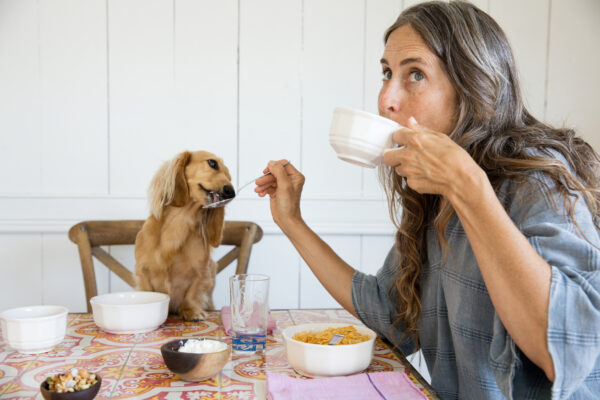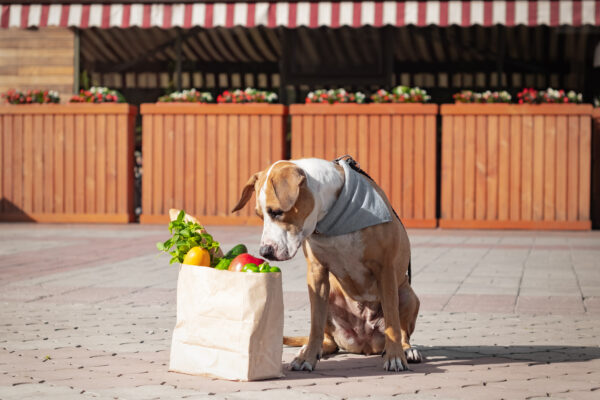Some dogs like to hide things. They might hide treats in couch cushions or food in holes in the yard — or some other curious combination.
While the behavior may seem strange through human eyes, it likely makes perfect sense to our pups.
Animal Behavior College Certified Dog Trainer Angela Logsdon-Hoover, of VCA Animal Hospitals, says there are actually many reasons why dogs hide or bury their treats or food — including:
- instinctive behavior
- breed-specific behavior
- resource guarding behavior
- attention seeking
- boredom
- nausea
The 6 reasons dogs hide food
These kinds of behaviors, burying or hiding food, all fall under the same general umbrella. In fact, Angela says it’s not only food and treats dogs may bury or hide, but toys too.
There are several possible reasons that dogs bury food:
1. Instinctive
“Caching is a behavior derived from wild canines in which they would bury food in the dirt — which acted as a refrigerator — to return to later in times of scarcity,” she says.
2. Breed predisposition
“Breeds that hunt small prey such as Terriers, Dachshunds, Basset Hounds, Beagles, etc., tend to display this behavior more often,” she says. “It is part of their natural drive. These predisposed breeds should be offered an appropriate place to dig and bury.”
3. Possessiveness and/or anxiety
“If a dog is concerned that his food or toys are in danger of being taken by another pet or human, he may hide them to keep them safe,” Angela says.
4. Attention-seeking behavior
“If digging in the yard for fun has historically caused you to yell at or chase your dog, he may see this as attention, even if it is negative,” says Angela. “Dogs are opportunistic, and if a behavior has gained them several rewards — such as expelling energy, your attention — they will continue to do that behavior.”
5. Nausea
“In some instances dogs who are nauseous may bury food because they don’t want to see or smell it,” Angela says. “They may use towels, blankets, laundry, etc., to cover up the food dish, to avoid putting the food in their mouth to take it to another location. “She says to consult your veterinarian if burying is a new behavior for your pet and is accompanied by other symptoms like hypersalivation.
6. Boredom
“High-energy dogs need a sufficient outlet for their energy,” says Angela. “If they have pent-up energy, they will naturally find a way to dispel it, such as digging, chewing, licking or barking.”
Where do dogs hide their treats?
There are different ways of exhibiting this behavior, such as hiding their food or treats in various locations.
Angela says dogs may bury toys or treats in couch cushions, under blankets, in holes in the yard, in bushes, or even hide the food underneath his own body.
California-based dog trainer Ash Miner, a certified trick dog instructor (CTDI) working on a master’s degree in animal behavior, says there are many dogs who will take things to their “den space,” whether that’s a crate, a dog bed, or under their parents’ bed.
“These items can be food items, but not always,” she says. “Sometimes, they do it with dog toys or things that smell like their owner — shoes and slippers are extremely common. This is their ‘stash’ of valuables.”
Ash says out of the thousands of dogs she’s worked with, about 40 percent display some version of this type of behavior. She says in her experience it is not more common in certain dog breeds or personality types.
“It is my experience that this is a learned behavior or genetic predisposition to the instinct,” she says. “All breeds and personality types may do this, regardless of upbringing and any possible emotional trauma. Please don’t assume that because a dog hides their goodies that they have been severely neglected, as that is more often not the case.”
Ash says there isn’t a certain age when this develops.
“I’ve seen this in puppies as young as 8 weeks old when they first come home,” she says. “In terms of the more aggressive resource guarding, that is genetic and there is usually a singular event that ‘turns on’ the aggressive response. That can occur at any time, and the event may not be something that stands out to us humans.”
Generally speaking, the behavior isn’t a bad thing, says Ash.
“I believe firmly that treat hiding or hoarding is a very fun activity for the dog, and I always recommend allowing a particular safe space for your dog to practice this,” she says. “Never take anything from the dog or their pile, unless it’s a forbidden item — something of yours, or something dangerous to your dog. If you do need to take something away, always trade for a treat or another object of equal or greater value. If your dog displays any aggression, stop immediately and call in a force-free trainer experienced in resource-guarding protocols to help you give your dog some tools to cope with situations where they may have to give things up, and give you the skills to be safe.”
Treat hiding can be fun for dogs
Dogs may bury or hide their treats and food for various reasons — but at its simplest, it may be instinctive and fun. If you notice this behavior in your dog, give him or her a safe space for partaking in the activity. But if you notice any signs of anxiety, aggression, stress or anything concerning, consult a professional.






